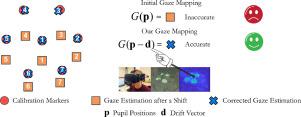当前位置:
X-MOL 学术
›
Comput. Graph.
›
论文详情
Our official English website, www.x-mol.net, welcomes your
feedback! (Note: you will need to create a separate account there.)
SalientGaze: Saliency-based gaze correction in Virtual Reality
Computers & Graphics ( IF 2.5 ) Pub Date : 2020-10-01 , DOI: 10.1016/j.cag.2020.06.007 Peiteng Shi , Markus Billeter , Elmar Eisemann
Computers & Graphics ( IF 2.5 ) Pub Date : 2020-10-01 , DOI: 10.1016/j.cag.2020.06.007 Peiteng Shi , Markus Billeter , Elmar Eisemann

|
Abstract Eye-tracking with gaze estimation is a key element in many applications, ranging from foveated rendering and user interaction to behavioural analysis and usage metrics. For virtual reality, eye-tracking typically relies on near-eye cameras that are mounted in the VR headset. Such methods usually involve an initial calibration to create a mapping from eye features to a gaze position. However, the accuracy based on the initial calibration degrades when the position of the headset relative to the users’ head changes; this is especially noticeable when users readjust the headset for comfort or even completely remove it for a short while. We show that a correction of such shifts can be achieved via 2D drift vectors in eye space. Our method estimates these drifts by extracting salient cues from the shown virtual environment to determine potential gaze directions. Our solution can compensate for HMD shifts, even those arising from taking off the headset, which enables us to eliminate reinitialization steps.
中文翻译:

SalientGaze:虚拟现实中基于显着性的注视校正
摘要 具有注视估计的眼动追踪是许多应用程序中的关键元素,从注视点渲染和用户交互到行为分析和使用指标。对于虚拟现实,眼球追踪通常依赖于安装在 VR 头显中的近眼摄像头。此类方法通常涉及初始校准以创建从眼睛特征到凝视位置的映射。然而,当耳机相对于用户头部的位置发生变化时,基于初始校准的精度会下降;当用户重新调整耳机以获得舒适感或什至将其完全取下一小会时,这一点尤其明显。我们表明,可以通过眼空间中的 2D 漂移向量来实现对此类偏移的校正。我们的方法通过从显示的虚拟环境中提取显着线索来确定潜在的凝视方向来估计这些漂移。我们的解决方案可以补偿 HMD 偏移,即使是摘下头显引起的偏移,这使我们能够消除重新初始化步骤。
更新日期:2020-10-01
中文翻译:

SalientGaze:虚拟现实中基于显着性的注视校正
摘要 具有注视估计的眼动追踪是许多应用程序中的关键元素,从注视点渲染和用户交互到行为分析和使用指标。对于虚拟现实,眼球追踪通常依赖于安装在 VR 头显中的近眼摄像头。此类方法通常涉及初始校准以创建从眼睛特征到凝视位置的映射。然而,当耳机相对于用户头部的位置发生变化时,基于初始校准的精度会下降;当用户重新调整耳机以获得舒适感或什至将其完全取下一小会时,这一点尤其明显。我们表明,可以通过眼空间中的 2D 漂移向量来实现对此类偏移的校正。我们的方法通过从显示的虚拟环境中提取显着线索来确定潜在的凝视方向来估计这些漂移。我们的解决方案可以补偿 HMD 偏移,即使是摘下头显引起的偏移,这使我们能够消除重新初始化步骤。











































 京公网安备 11010802027423号
京公网安备 11010802027423号